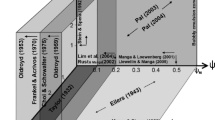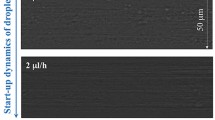Summary
The formulation of oil-in-water emulsions which have the mechanical properties of semi-solids, i. e. creams, involves both theoretical and practical problems. One solution is to use combinations of ionic or non-ionic surfactants with a fatty alcohol, as in Emulsifying Wax B. P., Cetrimide Emulsifying Wax B. P. C. and Cetomacrogol Emulsifying Wax B. P. C. By altering the total amount of such a mixed emulsifier in a formulation, the consistency may be varied from liquid to semi-solid. The rheological properties of such emulsions have been explained on the assumption that a viscoelastie network exists in the continuous phase, linking disperse phase globules. The nature, extent and strength of this network controls the flow properties of the system. This theory is discussed with particular reference to the anionic surfactant sodium dodecyl sulphate, the cationic surfactant cetrimide, and the long chain alcohols cetyl and stearyl and their mixtures. The importance of testing at small strains is emphasised e. g. creep and oscillatory testing, and it is shown that continuous shear methods, although theoretically less satisfactory, may also provide useful information.
Zusammenfassung
Das Formulieren von Öl-in-Wasser-Emulsionen mit mechanischen Eigenschaften von halbfesten Stoffen, wie z. B. Cremes, bringt theoretische und praktische Probleme mit sich. Die Kombination von ionischen oder nicht-ionischen oberflächenaktiven Stoffen mit Fettalkoholen, wie z. B. in emulsifying wax B. P., cetrimide emulsifying wax B. P. C. und cetromacrogol emulsifying wax B. P. C. ist eine Lösung. Durch Änderung des Anteiles eines solchen gemischten Emulgators in einer Formulierung kann die Konsistenz von flüssig bis halbfest variiert werden. Die rheologischen Eigenschaften sind unter der Annahme, erläutert worden daß in der kontinuierlichen Phase ein viskoelastisches Netzsystem vorhanden ist, das die kugelförmigen Anteile der dispersen Phase verbindet. Die Art, das Ausmaß und die Stärke dieses Netzwerkes beeinflussen das Fließverhalten des Systems. Diese Theorie wird diskutiert, wobei der anionische Emulgator Natriumdodecylsulfat, das kationische Cetrimide und die langkettigen Cetyl- und Stearylalkohole und Mischungen aus den beiden besonders berücksichtigt werden. Betont wird die Bedeutung des Testens unter geringen Belastungen, wie z. B. Kriechund oszillierende Beanspruchungen; es wird gezeigt, daß kontinuierliche Schermethoden auch brauchbare Aussagen liefern, obwohl diese in theoretischer und praktischer Hinsicht weniger befriedigen.
Similar content being viewed by others
References
Sherman, P., J. Pharm. Pharmac.16, 1–25 (1964).
Schulman, J. H. andE. G. Cockbain, Trans. Faraday Soc.36, 651–668 (1940).
Spalton, L. M. andR. W. White, Pharmaceutical Emulsions and Emulsifying Agents. 4th ed., pp. 73, 74 (London 1964).
Barry, B. W. andG. M. Saunders, J. Colloid Interface Sci.34, 300–315 (1970).
Barry, B. W. andE. Shotton, J. Pharm. Pharmac.19, Suppl. 110 S to 120 S (1967).
Lawrence, A. S. C., Disc. Faraday Soc.25, 51–58, 58–80 (1958).
Lawrence, A. S. C., Nature183, 1491–1494 (1959).
Lawrence, A. S. C., Chemy Ind., 1764–1771 (1961).
Lawrence, A. S. C., Surface Activity and Detergency, ed.K. Durham, p. 158–192 (London 1961).
Barry, B. W. andE. Shotton, J. Pharm. Pharmac.20, 242–243 (1968).
Dervichian, D. G., Proc. 2nd. Int. Congr. Surface Activity1, 327–333, 409–412 (1957).
Dervichian, D. G., Kolloid-Z.169, 107–111, 111 to 113 (1960).
Ekwall, P., I. Danielsson, andL. Mandell, 3rd Int. Congr. Surface Activity1, 189–192 (1960).
Ekwall, P., I. Danielsson andL. Mandell, Ibid.1, 193–196 (1960).
Gray, G. W., Molecular Structure and the Properties of Liquid Crystals, p. 28, Academic Press (London 1962).
Gstirner, F., D. Kottenberg, andA. Maas, Arch. Pharm.302, 340–353 (1969).
Epstein, M. B., A. Wilson, C. W. Jakob, L. E. Conroy, andJ. Ross, J. Phys. Chem., Ithaca58, 860–864 (1954).
Epstein, M. B., A. Wilson, J. Gershman, andJ. Ross, Ibid.60, 1051–1054 (1956).
Kung, H. C. andE. D. Goddard, Ibid.67, 1965 to 1969 (1963).
Kung, H. C. andE. D. Goddard, Ibid.68, 3465 to 3469 (1964).
Kung, H. C. andE. D. Goddard, J. Colloid Sci.20, 766–776 (1965).
Ekwall, P., L. Mandell, andK. Fontell, Liquid Crystals, Part 2, ed.G. H. Brown, pp. 325–381 (London, New York, Paris 1969).
Hyde, A. J., D. H. Langbridge, andA. S. C. Lawrence, Disc. Faraday Soc.18, 239–258 (1954).
Barry, B. W., J. Pharm. Pharmac.20, 483–484 (1968).
Talman, F. A. J. andE. M. Rowan, Ibid.20, 810–811 (1968).
Barry, B. W., J. Colloid Interface Sci.32, 551 to 560 (1970).
Scott Blair, G. W., A Survey of General and Applied Rheology, 2nd ed., pp. 76–87 (London 1949).
Van Wazer, J. R., J. W. Lyons, K. Y. Kim, andR. E. Colwell, Viscosity and Flow Measurement, A Laboratory Handbook of Rheology, pp. 122–129 (New York 1963).
Barry, B. W., J. Colloid Interface Sci.28, 82–91 (1968).
Davis, S. S., E. Shotton, andB. Warburton, J. Pharm. Pharmac.20, Suppl., 157S-167S (1968).
Warburton, B. andB. W. Barry, J. Pharm. Pharmac.20, 255–268 (1968).
Turner Alfrey, jr. andE. F. Gurnee, Rheology, Theory and Applications, ed.F. R. Eirich,1, pp. 387 to 429 (London, New York 1956).
Ferry, J. D., Ibid.2, pp. 433–473 (1958).
Ferry, J. D., Viscoelastic Properties of Polymers (London, New York 1961).
Leaderman, H., Rheology, Theory and Applications, ed.F. R. Eirich,2, 1–61 (London, New York 1958).
Davis, S. S., J. J. Deer, andB. Warburton, J. Sci. Instrument, Ser. 2,1, 933–936 (1968).
Davis, S. S., Ibid.2, 102–103 (1969).
Barry, B. W. andG. M. Saunders, J. Pharm. Pharmac.21, 607–609 (1969).
Van Wazer, J. R., J. W. Lyons, K. Y. Kim, andR. E. Colwell, Viscosity and Flow Measurement, A Laboratory Handbook of Rheology, pp. 344–352 (London, New York 1963).
Barry, B. W. andE. Shotton, J. Pharm. Pharmac.19, Suppl., 121 S-129 S (1967).
Davis, S. S., J. Pharm. Sci.58, 418–421 (1969).
Walters, K., Basic Concepts and Formulae for the Rheogoniometer (Bognor Regis [England] 1968).
Warburton, B. andS. S. Davis, Rheol. Acta8, 205–214 (1969).
Barry, B. W., J. Pharm. Pharmac.21, 533–540 (1969).
Author information
Authors and Affiliations
Additional information
Paper presented to the British Society of Rheology Conference on Rheology in Medicine and Pharmacy, London, April 14–15, 1970
Rights and permissions
About this article
Cite this article
Barry, B.W. Structure and rheology of emulsions stabilised by mixed emulsifiers. Rheol Acta 10, 96–105 (1971). https://doi.org/10.1007/BF01972485
Received:
Issue Date:
DOI: https://doi.org/10.1007/BF01972485




